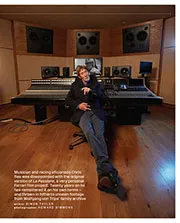The passion was kindled by watching Formula 1 races with his Italian-born father who assured the young Rea that Ferraris were the best cars in the world. He wouldn’t have needed much convincing. That season the sleek V6-powered Sharknoses won five of the eight World Championship rounds.
But it was Phil Hill who took the title instead of von Trips. The charismatic German lost his life in a second lap crash at Monza, which was thankfully not televised in Britain. Rea’s parents kept the news from him knowing that they would otherwise not get him to school the next day. He was heartbroken when he was told.
Rea’s chances of following in the footsteps of von Trips looked slim; his Middlesborough family’s ice cream business looked unlikely to produce the fortune needed to buy one of the cars.
Still, he did what he could. After passing his test in an ice cream van, he repainted his first car, a Ford Anglia, red, and made plans to work as a motor sport journalist.
It was only aged 22 that Rea picked up a guitar for the first time and taught himself to play. He wrote songs, joined a band and, two years later, released a single. Another two years on, in 1978, he had an album and the track Fool (If You Think It’s Over), which reached No12 in the US charts.
Rea was on his way to success — and the race track.
He began competing with a Caterham 7 and immortalised the model by using a picture of his blue Super Seven in the artwork for 1991 album Auberge, also featuring it in the music video of the title song.
He moved on to race a Lotus 23B, a Lola Mk1 and an Elan 26R, then an Intermarque Ferrari 308, in which he won a round at Donington. It was there he watched through the fence as Senna destroyed the field in the 1993 European Grand Prix — so rapt at the performance that he “came home with fencing marks on my face”

Rea at Snetterton in the 1980s
Bryn Colton/Getty Images
Later that year he drove a Porsche 911 Supercup car in the Monaco Grand Prix support race, and spent the rest of the time with the Jordan GP team, where he made a unique contribution to his driver Rubens Barrichello’s 21st birthday celebrations.
He’d assembled his band a few weeks before and recorded Happy Birthday to a Latin rhythm. The song was played over the public address system as Barrichello emerged from the drivers’ briefing.
Two years later he was back at Monaco with his friend Eddie, only his responsibilities had multiplied, and the singer was now part of the pitcrew.
“I was asked to be the left rear tyre cover man for the Monaco GP in 1995,” Rea told Motor Sport. That was a great experience, being so close to it all, and standing out the back watching the cars through the swimming pool section.”
In an interview with the BBC, he added: “I got to wear me own suit and helmet in the garage. I really didn’t want to do the VIP thing, so I was in charge of Eddie Irvine’s right-rear tyre.”
Of course, some of the VIP perks did appeal. “I drove the [1993] Jordan 193 at Silverstone,” he said. “Unbelievable – to be driving an F1 car, just incredible. Those brakes! First time, braking for Stowe, I could feel my breakfast coming back up.”
At this point, music and racing were merging for Rea. He released a song in tribute to Senna: Saudade, and was also working on La Passione, the tale of a small boy whose family makes ice cream, and who is obsessed with Ferrari and von Trips.
Initially conceived as an extended music video for a series of connected songs, it required a recreation of the 1961 Formula 1 season, where the appearance of Ferrari’s Sharknose was non-negotiable, even though they had all been scrapped by the end of 1963.
“I showed the photos of [Ferrari driver] Willy Mairesse’s car upside down at Spa to an engineer from Shoreham who was racing Caterhams and he realised that it was very simply put together, a simple construction,” said Rea. “That’s how they were in the early 1960s. He built me one for £30,000.”

Rea on the set of La Passione
Getty Images
Phil Hill, who won the 1961 world championship with the car was impressed enough to drive it at the Goodwood Festival of Speed.
“Of course it was a great moment when Phil drove it, I was in tears,” said Rea. “But then the car became a problem, everyone wanted to sell me an engine, or some old ‘genuine’ parts and I just didn’t need the hassle of it any more. Too stressful, too complicated, no more joy.”
He could have been describing the film which, Rea said, was taken over by Warner Brothers, reimagined as a complete film, and was panned on release.
Rea eventually bought the rights to the film and re-released it in 2016, with a film that better reflected his original vision while the project inspired the creation of further reproductions.
His racing exploits continued: in 2009, he raced a Ferrari 328 in the European Ferrari Challenge series then bought an ex-police 1957 Morris Minor, which he competed in as recently as 2020, racing it at Thruxton in panda car livery.



